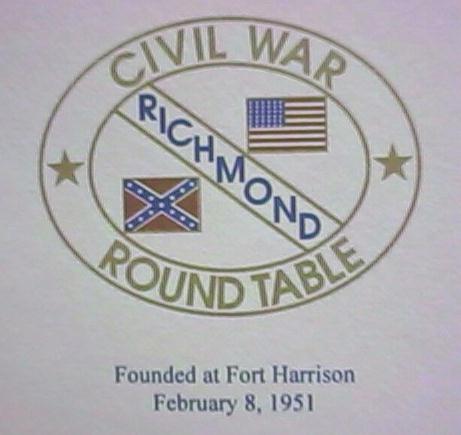


January 2002
Clark H. Lewis, President Art & Carol Bergeron, Editors P. O. Box 1122 3901 Paces Ferry Road Richmond, VA 23218 Chester, VA 23831-1239 January 2002 PROGRAM
John C. Waugh "The Class of 1846: The Civil War's Band of Brothers" 8:00 p.m., Tuesday, January 8, 2002, at the Boulevard United Methodist Church, 321 N. Boulevard, Richmond, VA (corner of Boulevard and Stuart Ave.) John C. Waugh is the author of the prize-winning book The Class of 1846: From West Point to Appomattox - Stonewall Jackson, George McClellan and Their Brothers (1994); Reelecting Lincoln: The Battle for the 1864 Presidency (1997); and Sam Bell Maxey and the Confederate Indians (1995). His latest book, Last Stand at Mobile is due out this month. Waugh's writings have appeared in the New York Times, the Los Angeles Times, the Boston Globe, American Heritage, and Civil War Times Illustrated. A native of Clarksburg, West Virginia, he began his career as a freelance writer in that state. Waugh is the former newspaper correspondent and bureau chief of the Christian Science Monitor. He was also an aide to Nelson Rockefeller. Now retired, he lives in Arlington, Texas. Waugh will speak on The Class of 1846 and the characters in it. The book details the famous West Point graduates of that year. The class included some of the most famous military leaders in American history, including George B. McClellan, Thomas J. "Stonewall" Jackson, and George E. Pickett. These men went from the parade ground at the United States Military Academy to the battlefields of the Mexican War. All of them gained practical combat experience for the war that would erupt in 1861. The leading generals of the Civil War personally knew their opponents on many of the battlefields where they fought against each other. Some of the latter, like Antietam, were what one person has described as "practically a class reunion." Waugh will not only cover the more well known officers but will also look at some of the less celebrated.
Review of the December Program
 |
Announcements
Round Table Raffle The January raffle item is a nicely bound 2-volume set of The Long Arm of Lee by Jennings C. Wise.
New Officers The following slate of officers was elected at the December meeting-Clark Lewis, President; Brag Bowling, First Vice President; and Art Bergeron, Second Vice President. Jack Ackerly, Bob Krick, and Scott Mauger were named to the Executive Board.
Membership Renewal A separate mailing will be made in 2002 so that people can renew their membership in the Richmond Civil War Round Table. You should expect to find the renewal notice in your mailbox in the near future.
Newsletter Deadlines To facilitate the printing and timely distribution of the monthly newsletter, information for it should be submitted to the editors no later than the following dates: January 18 for February; February 22 for March; March 22 for April; April 19 for May; May 24 for June; June 21 for July; July 19 for August; August 23 for September; September 20 for October; October 18 for November; and November 22 for December.
Richmond Civil War Round Table Speakers for 2002 January - John C. Waugh February - John Quarstein March - William J. Cooper, Jr. April - Edward Smith May - Frank O'Reilly June - Gordon Rhea July - Cramer Gallimore August - not determined September - not determined October - Gabor Boritt November - Jay Winick December - William C. "Jack" Davis
Museum of the Confederacy Programs Civil War Encounters. These are living history encounters at the Museum where costumed historians portray eyewitnesses to significant Civil War events and will occur one Saturday each month. The first will be held on January 26 at 2:00 p.m. In "The Battle of Trent's Reach," a quarter gunner describes the Confederate attack on the last remaining Union ironclad during the battle of Trent's Reach, January 1865. Free with Museum admission. Lee-Jackson Day. On Friday, January 18, from 10:00 a.m. to 5:00 p.m., the Museum will remember Robert E. Lee and Thomas J. "Stonewall" Jackson on the official state holiday. Admission is free to the Museum all day. Children's Activity Day. On Saturday, January 19, from 1:00-4:00 p.m., bring your family to enjoy crafts, special demonstrations and living history for an exciting afternoon of Civil War history. Free with Museum admission. Find Your Civil War Ancestors Workshops I & II. On Sunday, January 20, and Monday, January 21, from 2:00-4:00 p.m. both days, join Museum library staff for an introduction of sources and techniques to identify and locate Confederate ancestors and trace their wartime experiences. Space is limited; call today. $15/free to members. RSVP to 649-1861, ext. 28.
Richmond Civil War Round Table Newsletter Art & Carol Bergeron, Editors 3901 Paces Ferry Road Chester, VA 23831-1239
Return to News Letters Index
Return to main page

©R.C.W.R.T. 2002